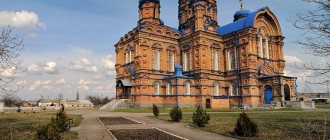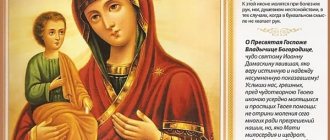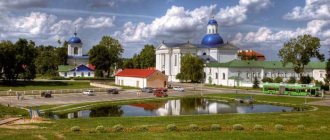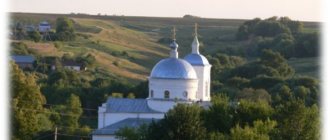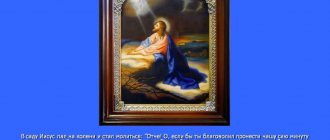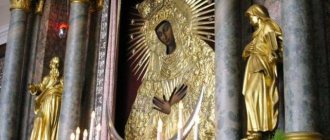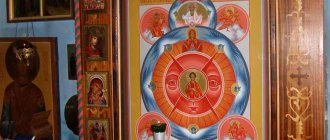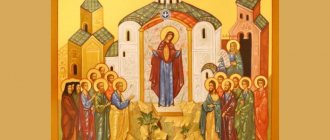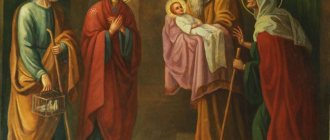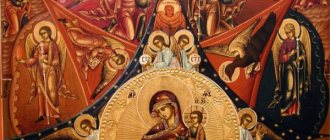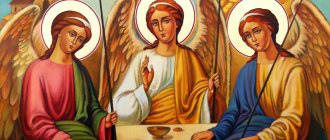| Icon of the Mother of God “Consolation in Sorrows and Sorrows” |
Icon of the Mother of God “Consolation in Sorrows and Sorrows”
Celebration November 19
Dating back to the 17th century. There is a legend that the icon belonged to the Patriarch of Constantinople, Saint Athanasius III Patelarius, with whom it went on all the wanderings and travels of the Bishop and in 1653 first arrived in Russia. After the death of the saint in 1654, it passed to the elder, who lived in retirement in the Vatopedi monastery on Holy Mount Athos.
On the day of the opening of the Athos St. Andrew's monastery on October 22, 1849, Metropolitan Gregory, who was living in retirement in Vatopeda, presented the icon to the first abbot of the skete, Vissarion (Tolmachev), as a blessing from the monastery and due to the fact that this image had previously been the cell icon of Patriarch Athanasius III Patellarius, on the spot the cells of which St. Andrew's monastery arose.
In August 1853, the icon was sent by sea to Odessa, and from there by mail to St. Petersburg to Hieromonk Theodorit (Krestovnikov), who was collecting funds for the monastery in Russia. In November, he received the icon with significant damage and, probably, in July 1859, returning to Athos, he returned it to the monastery. Before his death in 1862, Abbot Vissarion (Tolmachev) handed over the icon to the brethren with the prophetic words: “ May it be joy and consolation to you in sorrows and sorrows.”
«.
In August 1863, during the icon’s second stay in Russia during the period of Hieromonk Paisius collecting funds for the construction of St. Andrew’s monastery, in the Kazan province the icon showed miraculous power in healing people. The first miracle from the icon was recorded on November 19 of that year in the convent in honor of the Nativity of Christ in the city of Slobodskoye, where the abbess was nun Pulcheria, the daughter of Father Philaret (Philip Filimonovich Sazonov), one of the first inhabitants of the St. Andrew's monastery - an 18-year-old student gained the gift of speech Vyatka Theological School Vladimir Nevolin. On Christmas 1857 he went to the village of Kyrmyzh, Vyatka district. On December 31, on the porch of the church, someone ordered the message to be conveyed to his father, Hieromonk Neon, a resident of the Slobodsky Holy Cross Monastery, and warned that if he did not do this, he would suffer. The young man did not fulfill the order and soon began to feel unwell. On the 1st day of Lent, he had a vision of 3 luminous men, one reproached him for not following orders and predicted his punishment - dumbness. Vladimir told his sister, the priest’s wife, about the vision. That same day he went numb. 6 years later, when Vladimir venerated the icon after a prayer service, he felt “a heat in his tongue that spread throughout his whole body.” Returning home, he suddenly spoke. His first words were: “ What a wonderful diamond crown on the Mother of God!”
«
From that moment on, healings from the icon began to occur continuously. On November 22, the tongue-tied daughter of the sexton of the Sretenskaya Church in the city of Slobodskoye, Paraskeva Ovchinnikova, spoke; on November 24, peasant Nikolai Vorozhtsov was healed of paralysis of his legs; a seven-year-old girl, Ksenia Kaysina, was healed of a leg disease; and a three-year-old boy, Pyotr Likhachev, was healed of seizures; On December 4, a four-year-old boy, Vasily Kibardin, suffered from bone inflammation. In the two months after the first miracle, many similar evidences were recorded [1].
In 1876-1882, the icon was again in Russia, accompanied by Hieromonk Ezekiel, and healings of the sick were again observed. In 1890, by decision of the brethren of St. Andrew's monastery, the icon was sent to Russia forever. She was accompanied by the future abbot of the monastery, Hieromonk Joseph (Belyaev). On March 3, the icon was solemnly welcomed in Odessa, where two girls were healed from demonic possession in the cathedral church. March 14 - at Borki station. March 16 - in Rostov-on-Don, where a case of healing from demonic possession was also recorded. Then the icon was met in Novocherkassk, in Moscow, at the Athos monastery in St. Petersburg.
At stopping places, prayer services were held with the gathering of a huge number of believers. In 1890-1891, Hieromonk Joseph in St. Petersburg recorded 21 healings from various ailments. From September 17 to October 2, the icon was in Uglich and its environs, where healings were also performed from it.
In the service of the icon they began to use the troparion, kontakion and akathist to the icon of the Mother of God “Quench my sorrows.” On February 6, 1915, at the Petrograd courtyard of the St. Andrew's monastery, Metropolitan of Petrograd Hieromartyr Vladimir (Epiphany) began to perform a vigilant prayer in front of the miraculous icon for the granting of victory to the Russian army.
In 1933, the revered image was transferred to the St. Nicholas Cathedral. The custom was established to bring the icon out on its feast day in the evening of December 1 for the evening service and on December 2 for the Liturgy; most often the icon was then located in the center of the temple until the end of the day [2]. Nowadays the shrine is kept in the altar of the cathedral [3].
| Icon of the Mother of God “Consolation in sorrows and sorrows.” List of 1890. Athonite St. Andrew's monastery. |
Origin story
Unfortunately, the original icon has not survived to this day. Only its deep history and miracles have been preserved. Churchmen believe that it was written in the 17th century in Byzantium. It is known that initially it belonged to St. Athanasius III, Patriarch of Constantinople, as a cell icon. After the death of the bishop, it passed to the elder of the Vatopedi monastery on Holy Mount Athos.
Then, she arrived at the hieroschemamonk Vissarion (Tolmachev) - the first abbot of St. Andrew's monastery on Athos. The icon was brought as a gift by Metropolitan Gregory as a sign of the blessing of the monastery, which was built on the site of the cell of Patriarch Athanasius III Patellarius.
Icon “Consolation in Sorrows and Sorrows.”*
- In 1853, the icon was sent to Odessa by sea, and then transferred by mail to St. Petersburg. The addressee was Hieromonk Theodorit (Koestovnikov). With the help of the icon, he raised funds for the Athos monastery. Thus, the icon came to Russia for the first time. Here she arrived for several months and was returned to the hieromonk with severe damage. She returned to Athos in July 1859 (presumably).
- In 1862, Abbot Vissarion gathered the brethren and handed over the icon, uttering the prophetic words: “May it be joy and consolation for you in sorrows and sorrows” (quote). This happened before his death. This is how the icon acquired its famous name.
- In 1863, the icon’s second journey to Russia took place, now to the Kazan province. The icon was accompanied by Hieromonk Paisius.
- In November of the same year, the first miraculous healing occurred. It happened like this. In the city of Slobodsky, Vyatka province, there was a convent in honor of the Nativity of Christ. Its abbess was the nun Pulcheria. (Her father Filaret was one of the first to become a resident of St. Andrew’s monastery).
In this temple, Vladimir Nevolil, the son of a local priest, regained the gift of speech after six years of muteness. This happened after finishing the prayer at the icon “Consolation in Sorrows and Sorrows,” when he touched it with his lips and felt “a strong warmth on his tongue and throughout his whole body.” When he returned home, he could speak as before. The first thing he said were the words: “What a wonderful diamond crown on the Mother of God!”
From that moment on, miracles began to happen very often. On November 22, Paraskeva Ovchinnikova, the daughter of the sexton of the Sretenskaya Church in the city of Slobodsky, was able to speak coherently and beautifully. Before that, she had a terrible tongue tie. Two days later, peasant Nikolai Vorozhtsov’s paralysis disappeared. Then, three-year-old Pyotr Likhachev’s seizures stopped. The sore legs of a seven-year-old girl, Ksenia Kaysina, have recovered. In early December, the boy Vasily Kibardin recovered from bone inflammation. During the two months that the icon was in Russia, many similar events occurred.
- The third stay of the miraculous image in Russia took place from 1876 to 1879.
- And in 1890, the brethren of St. Andrew’s Skete decided to leave the icon in Russia forever. Accompanied by Hieromonk Joseph (Belyaev), she arrived in Odessa, from where she was transported to St. Petersburg.
During the journey through Rostov-on-Don, Novocherkassk, Moscow and other cities, several miraculous healings occurred after crowded prayer services with a huge crowd of believers. A total of 21 cases were recorded in which patients were deprived of their ailments.
- Later, the icon was transported to the Annunciation Monastery at the courtyard of St. Andrew's monastery in St. Petersburg. After 1929, the original image disappeared without a trace. Fortunately, an exact copy of it remains.
Icon "Consolation in sorrows and sorrows." List of 1890 Athos St. Andrew's Skete.*
In 1890, the original was donated by Athonite monks to the Orthodox believers of Russia. Before the act of donation, a list was created in the St. Andrew's Skete on Mount Athos, which was placed on the gates of St. Andrew's Cathedral.
Miracles Revealed
The icon stayed in Greece for only 4 years, then it was sent back to Russian lands. The mission is still the same - now with Hieromonk Paisius. This time she had to raise funds for the monastery in the Kursk province.
From then on, the fame of the miracles that occurred with the help of this icon spread throughout Russia. In order to strengthen people's faith in the Lord, all the miraculous phenomena that happened after praying to the Mother of God in front of this image were recorded in books. They were kept and protected as evidence of the miraculousness of the icon.
The first case of miraculous healing occurred with a mute student in the Vyatka district in 1863. It is evidenced by an entry in the church register of the parish church in the village. Kyrmyzh. The young man himself was from a religious family and studied at a theological school. One day he entered the temple, and a certain wanderer stopped him on the porch. He needed the young man to simply tell his father some message. The student ignored the request.
After this, he has a dream where three saints condemn him for his frivolity and promise to punish him. In the morning the guy could no longer utter a word. He was speechless. Six years passed in silence, and then the icon was delivered to the village church. When the prayer service ended, the one who had not spoken for many years kissed it. He felt that his tongue seemed to be on fire and after that he was able to speak.
Other miracles also happened. They poured out with grace on those who, full of faith, approached the image with prayer. There are numerous witnesses to this who confirmed their words with signatures.
At the same time, when the unfortunate student gained the gift of speech, in October 20, the sexton’s tongue-tied wife Akulina Frolova, who had barely uttered words since childhood, began to speak after prayer. In November of the same year, Savely Ermakov, a tradesman who had been paralyzed for a long time, also recovered. A day later, the woman in labor, E. Martynova, the merchant’s wife, who had lost the last sparks of life from fever after the birth of her child, regained strength and health.
There are many similar miracles described in the book. Even more remain undocumented.
Other lists
Copies began to be distributed in the second half of the 19th century, after the icon first visited the Vyatka province.
- The first list was created by the same Vladimir Nevolin, who was healed of muteness. He was in the Vyatka Monastery of the Exaltation of Christ. In 1866, the list was supplemented with an elegant chasuble, which was made on Mount Athos.
- Nevolin created another copy in 1864 for the Novolinsky Cathedral of St. Nicholas.
- In 1882, in the Vyatka province in the city of Slobodskoye, the Transfiguration Monastery was built in honor of the icon of the Mother of God “Consolation in Sorrows and Sorrows.” The list for this temple was created by Hieromonk Paisius. The one who brought the original icon from Athos to the city of Slobodskoye in 1863. All religious processions took place with this icon in different cities of the province, and twice a year on December 12 and January 25, it was brought to Vyatka. One of the most famous copies was the one that is now located in the Catherine Cathedral in Slobodsky.
- Another list was created for the church with. Vishkil, Vyatka province.
- In 1905, a list was created in the cell of St. John Chrysostom of the Hilandar Monastery.
- Preserved to this day. Now kept in the Alekseevo-Akatovo convent
Voronezh. In 1999, the icon flowed myrrh very abundantly. This has happened several times since then, but less severely.
The list of 1905 was created in the cell of St. John Chrysostom, decorated with the following inscription: “This icon was painted and consecrated on Holy Mount Athos in the Russian Monastery of St. John Chrysostom under the rector Hieroschemamonk Kirill in 1905.”*
- In 1913, another list was written at St. Andrew's Skete and presented to Bishop Veniamin (Kazan) of Gdov (now numbered among the holy martyrs). In 1917, after the Bolsheviks murdered the shepherd of Tsarskoye Selo (Pushkino) - Hieromartyr Ioan (Kochurov), Bishop Benjamin donated the above-mentioned icon to the parishioners as a gift of consolation. The image was placed in St. Catherine's Cathedral, where it remained until 1939, when it was blown up by the local Soviet authorities. Then many icons and church utensils were burned in the courtyard of the temple. But, fortunately, the miraculous list remained intact. In 1995, he returned first to the St. Sophia Cathedral in Pushkino, and after the restoration of the Catherine Cathedral in 2012, to its former place, to the revived temple.
Icon of the Mother of God “Consolation in Sorrows and Sorrows” from St. Catherine’s Cathedral in Pushkin. List of 1913 from St. Andrew's monastery on Mount Athos.*
In St. Petersburg, in the Annunciation Church of the Blessed Virgin Mary (in the bishop's courtyard, formerly the courtyard of the Athos St. Andrew's monastery) there is a list that contains particles of the relics of those saints depicted on the icon.
Literature
- Description of the miracles that took place before the miraculous icon of the Mother of God “Consolation in Sorrows and Sorrows,” located in Rus. on Mount Athos St. Andrew's hostel monastery // Kr. ist. essay Rus. on Mount Athos of St. Andrew's hostel monastery. Od., 1890, 19126;
- Monuments of Christ. antiquities and shrines in the Svyatogorsk Athos monasteries. // Instructions and consolations of St. Christian faith. 1902. No. 1. P. 74-85;
- Chronicle of St. Andrew's Skete. St. Petersburg, 1911. P. 171-172;
- Third trip to Russia from Mount Athos from St. Andrew's Rus. monastery of the miraculous icon of the Mother of God “Consolation in sorrows and sorrows”: Description of miracles. Od., 1912. P. 123;
- [Description of miracles] // Instructions and consolations of St. Christian faith. 1915. No. 4. P. 189;
- Abode of the Never Sleeping in St. Petersburg // Ibid. 1916. No. 5. P. 160;
- Lyubomudrov A. Mother Pulcheria - an ascetic of the city of Slobodsky // Vyatka Diocese. Vestn. 1997. No. 8 (88).
Description and meaning of the icon (Athos list 1890)
The appearance is a folding one with doors. Its total size is 40 cm in length, 31 cm in height.
The central part is filled with the image of the Mother of God. She is holding the Christ Child. He holds a scepter in his left hand and blesses with his right.
Their robes are embroidered with gilded patterns.
Next to them are John the Theologian and John the Baptist.
Below them are the faces of Anthony the Great, Sava the Illuminated, Euthymius the Great and Onuphrius the Great. On the right wing of the fold are depicted:
- Nicholas of Myra (top right),
- St. George the Victorious on horseback (below).
On the left side in the upper part are Spyridon of Trimifuntsky and Dmitry of Thessalonica (on horseback).
Experts attribute the “writing style” to a technique that indicates “the centuries-old antiquity of this icon.”**
The meaning inherent in it symbolizes the protection of all the saints who surround the Mother of God and the Child Christ. They heal the sick, both with words and weapons. Because some ailments come from evil spirits. The icon protects you from it. Thanks to her, many miraculous healings occurred. But they pray to her not only for ailments.
Prayers to Saint Barbara
The Orthodox ask this ascetic to admonish other people (most often loved ones) to turn to Christ and learn the sacrament of communion and baptism.
This does not mean imposing and planting doctrines and views, but caring for other people, which also implies the need to tell the Good News and allow them to join the true faith.
The icon of St. Barbara is one of the few where a chalice (a communion vessel in which wine is blessed) can be part of the image. This attribute is associated with one of the main functions of the ascetic - to confess and give communion to those who could not do this in the normal way.
In addition, the saint’s prayer is especially effective and is most often used when asking:
- about healing from various ailments, from which the image of a saint, relics and simply sincere prayer help;
- about strengthening in faith when some vague doubts, despondency or something similar appear;
- about protection from various misfortunes and dangers, the opportunity to receive the help of the Almighty in difficult moments;
- about favorable childbirth and childbearing;
- about getting a worthy spouse;
- about the health and normal upbringing of children.
In addition to this, of all the things that the martyr Varvara helps with, one should also specially note the prayers for people who died without communion and confession. In order for others to find peace in the other world, they pray to this particular saint and ask to intercede with the Lord, so that they receive indulgence and ultimately can partake of the Holy Mysteries of Christ.
In fact, such an opportunity is practically equal to the favorable repose of the soul. Therefore, in the Orthodox tradition, this ascetic is especially revered, and significant hopes are pinned on her intercession.
In the Orthodox Church, the day of remembrance of Barbara is celebrated on December 17. On this day, it is especially useful to attend the service and venerate the icon, as well as read your own prayers at home.
What does it help with?
The help of the icon is contained in its name. Most often, sadness is caused by illness, and the image “Consolation in sorrows and sorrows” protects against them. An example of this is the many evidence of miraculous recovery from various ailments, documented by clergy in different years of prayer before the icon.
Remembering what diseases the icon healed from in former times, today people pray in front of it for a cure for paralysis, headaches, dumbness, and depression associated with physical weakness.
Another historical example of the icon’s help is the constant prayer in front of it for the Russian soldiers of the First World War. On February 6, 1915, his Petrograd Metropolitan Vladimir began to perform a prayer service for the preservation of life and health of soldiers and officers of the Russian Army, and for their victory over the enemy. The words written by the monks at that time have survived to this day. The Akathist is read when the Mother of God is asked to protect Orthodox believers from any evil, sorrows and misfortunes.
Gift of the Athonite Elders
Hieromonk Paisius returned safely to Greece and took the icon there. However, the people did not forget her power and miracles. Piteous letters were sent to Saint Athos, in which the Orthodox begged for the return of their beloved image, at least for a short time.
In 1876, this icon of the Mother of God was again brought to Russia to the glorious city of Rostov. In 1890, it was decided to leave her on Russian soil forever, in St. Petersburg.
There was already a courtyard there and Hieromonk Joseph had to take her there. On the way to the capital, the icon visited different cities: Odessa (two demoniacs were healed), the great Rostov-on-Don, Novocherkassk, and even visited Moscow. Grace descended upon the suffering everywhere. She was greeted by crowds of pilgrims, and the ringing of bells was constantly heard.
All miraculous phenomena associated with prayer to the icon were recorded and witnessed. A total of 20 are known.
The beloved icon gave its strength to believers even in the terrible years of strife. During World War I, Metropolitan Vladimir of Petrograd ordered everyone to pray for victory. A special akathist was read.
Where to hang
Those who have been going to church for a long time know well that icons in the house should be in the best and most visible place. In ancient times, they were necessarily located in the eastern part. That's right, they are located in the church. Often modern interior layouts do not allow this rule to be observed. Therefore, icons can be in any living space and even in the kitchen. When looking for a suitable place in the house for the icon “Consolation in Sorrows and Sorrows”, it is worth considering that it is better to position the image so that the whole family can gather for prayer. So it turns out that the most suitable room is the living room. A spacious kitchen is also well suited for this purpose.
If there is a seriously ill person in the family who cannot move independently, it is better to hang the icon so that he can see it without difficulty and can pray at any time.
Wherever the icon is located, there should be no objects next to it that are not related to prayer, much less distract from it.
If it is not possible to find a separate place for the iconostasis, you need to make sure that unnecessary things are removed or closed, at least temporarily.
Saint Barbara: life
Holy Martyr Barbara. Icon
The Holy Great Martyr Barbara is the same age as many martyrs and martyrs. This was a period of persecution of the Church, and that time gave our history such martyrs and martyrs as Varvara, Catherine, Paraskeva, Anastasia, Panteleimon, George, Demetrius and hundreds of thousands of believers who suffered not only in the Roman Empire, but suffered in Antioch, Alexandria and in other places, with which they glorified their life with a feat.
Barbara was born into the family of the pagan Dioscorus, who was a very noble and wealthy man in the city of Iliopolis in Phoenicia (modern-day Lebanon). Her mother died when Varvara was still little, and raising her daughter fell entirely on the shoulders of her father, who, wanting to hide his daughter from prying eyes, built a tower where, besides Varvara, there were only her pagan teachers and servants.
From the tower there was a beautiful view of mountains, rivers, and plains covered with flowers. And the girl, contemplating this world, gradually came to know the True Creator. She began to ask herself the question, who could create such beauty? Who is the Creator of the Universe? Gradually she came to the idea that paganism was soulless idols that could not arrange the world around them in such a way. And she wanted to know more about it.
Meanwhile, despite her imprisonment, rumors of Varvara’s extraordinary beauty spread throughout the city. And the most noble suitors asked for her hand. And just as her father did not ask her to accept the proposal and get married, she refused the marriage and warned that if they insisted, such persistence could end tragically.
We advise you to study Prayers to Antonio the Great
The father, fearing that his daughter’s character had changed due to her secluded life, allowed her to leave the tower periodically and choose friends for herself. And Varvara met her peers in the city, who were Christians and told her about faith in Christ and His saving power. She was kindled with all her heart when she heard the answers to the questions that she had repeatedly asked herself, and she wished to accept the Sacrament of Baptism.
After some time, a priest came to Iliopol under the guise of a merchant, who performed the Sacrament of Baptism.
At that time, a bathhouse with two windows was built at her father’s house, but on the advice of Varvara, as described in the canon, in the akathist, a tower with three windows was built. Testimony in honor of the Trinity - the trinitarian light from heaven, which sanctifies every soul. Above the entrance she inscribed a Cross, which was firmly imprinted on the stone. “And according to legend, where she stood on the threshold there was still raw material that froze, leaving a trace of her foot, from which a spring of living water flowed, which to this day has great healing power,” said Metropolitan Pavel.
In Raphael's famous painting The Sistine Madonna, Saint Barbara is depicted to the right of the Virgin and Child.
When the father arrived from a business trip, he was dissatisfied with the violation of the construction plan, and his daughter told him about the saving power of the Lord and the Triune God, that she recognizes only one God - the crucified Christ. He burned with hatred and anger.
At first he tried to dissuade her with admonitions and gifts. But she did not accept all this, because she accepted the Heavenly Bridegroom with all her heart. Then the father grabbed the sword to hit her, but she ran away, and the father rushed after her. A mountain blocked her path, but it parted and hid her in a crevasse. And she took refuge in one of the caves. For a long time the father could not find his daughter, but the shepherds indicated the place where she was. He found her, severely beat her, took her into custody, and starved her to death. Then he handed it over to the ruler of the city, Martian.
She was brutally tortured, scourged, and fresh and deep wounds were rubbed with hair shirt (a coarse fabric made from goat hair). And at night in prison, where the saint prayed to the Lord Jesus, the Savior Himself appeared to her and healed her wounds.
The next day, Saint Barbara was subjected to even more sophisticated torture. The Christian Juliana, standing in the crowd, was filled with sympathy for the suffering of this beautiful and rich girl and also wanted to suffer for Christ, beginning to loudly condemn the tormentors. They grabbed her too.
They were tortured for a long time: they tore their bodies with hooks, cut off their skin, and led them naked around the city with beatings and abuse. But, through the prayers of the saint, the Angel of the Lord covered the body of the martyrs with radiant clothing. After much torment, the martyrs were beheaded. Varvara was executed by her father. “It should be noted that soon God’s retribution befell both Dioscorus and Martian - they were burned by lightning,” noted Bishop Paul.
During the execution of Saint Barbara, blood and milk flowed from her body and vessels - evidence that the holiness of life always has superiority over all the events that happened.
